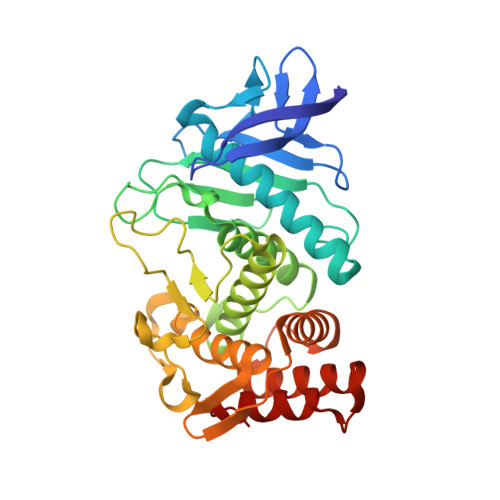How Nothing Boosts Affinity: Hydrophobic Ligand Binding to the Virtually Vacated S1' Pocket of Thermolysin.
Krimmer, S.G., Cramer, J., Schiebel, J., Heine, A., Klebe, G.(2017) J Am Chem Soc 139: 10419-10431
- PubMed: 28696673
- DOI: https://doi.org/10.1021/jacs.7b05028
- Primary Citation of Related Structures:
5LVD, 5M5F, 5M69, 5M9W, 5MA7 - PubMed Abstract:
We investigated the hydration state of the deep, well-accessible hydrophobic S 1 ' specificity pocket of the metalloprotease thermolysin with purposefully designed ligands using high-resolution crystallography and isothermal titration calorimetry. The S 1 ' pocket is known to recognize selectively a very stringent set of aliphatic side chains such as valine, leucine, and isoleucine of putative substrates. We engineered a weak-binding ligand covering the active site of the protease without addressing the S 1 ' pocket, thus transforming it into an enclosed cavity. Its sustained accessibility could be proved by accommodating noble gas atoms into the pocket in the crystalline state. The topology and electron content of the enclosed pocket with a volume of 141 Å 3 were analyzed using an experimental MAD-phased electron density map that was calibrated to an absolute electron number scale, enabling access to the total electron content within the cavity. Our analysis indicates that the S 1 ' pocket is virtually vacated, thus free of any water molecules. The thermodynamic signature of the reduction of the void within the pocket by growing aliphatic P 1 ' substituents (H, Me, iPr, iBu) reveals a dramatic, enthalpy-dominated gain in free energy of binding resulting in a factor of 41 000 in K d for the H-to-iBu transformation. Substituents placing polar decoy groups into the pocket to capture putatively present water molecules could not collect any evidence for a bound solvent molecule.
Organizational Affiliation:
Department of Pharmaceutical Chemistry, University of Marburg , Marbacher Weg 6, 35032 Marburg, Germany.



















